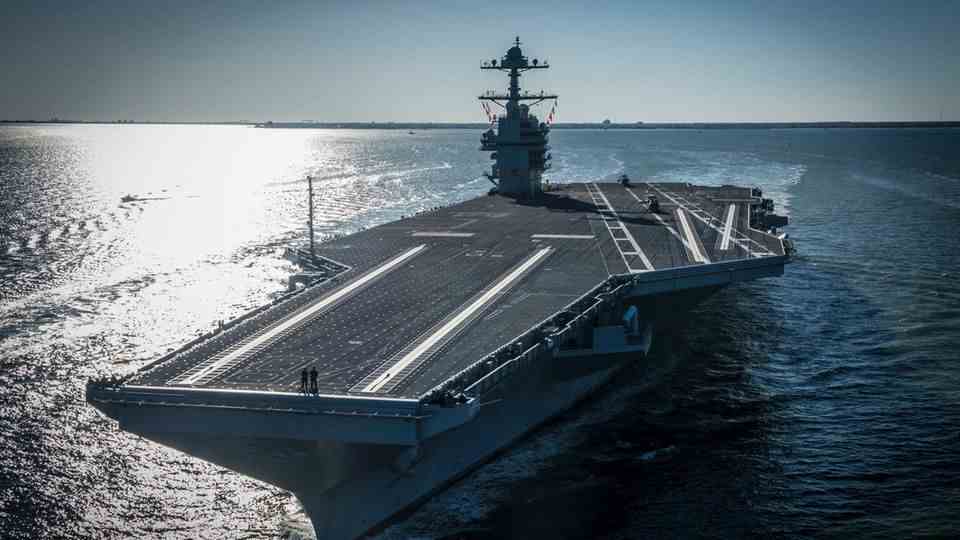Upgrade Type 003
China’s new aircraft carrier – smaller, but already on the level of the US carriers
The tents on the deck hide the catapults.
© Li Gang / Picture Alliance
Type 003, the Fujian, is China’s emergence into a powerful global navy. In just 10 years, Beijing has caught up with 80 years of aircraft carrier history.
China has launched its newest carrier, the Type 003. This does not mean that the ship is operational or handed over, just that it has left dry dock. Type 003 – Fujian- is the first all-Chinese carrier. The two previous models are based on prototypes from the Soviet era. These are smaller than the US carriers and their task was also different. They were not intended to allow world projection of air power, but only to protect the USSR surface fleet. The Liaoning – Type 001 – entered service with Beijing in 2012 and the Shandong – Type 002 – in late 2019.
The main difference to the US carriers is the lack of a catapult system, with which the starting aircraft are accelerated. 001 and 002 only have a kind of ski jump. In this way, the Soviets saved themselves the complex and space-consuming technology of a steam-powered catapult. In return, they had to accept significant losses in the take-off weight of the jets and the number of possible starts.
Type 003 is now catching up a lot. It is similar in size – around 85,000 GRT – and in design to the US carriers, including that 003 will have catapults. 003 will presumably skip the steam era and jump straight into electromagnetic catapult technology first installed on US Ford-class carriers. Electrical engineering offers several advantages. The system is smaller than a steam plant, easier to maintain, safer and requires fewer personnel. In addition, it can be adapted to the launch of different missiles at the push of a button.
Catapults and increased size allow Type 003 to accommodate a far larger air force. In addition to combat aircraft, 003 will carry drones and, for the first time, air surveillance aircraft. Thus, 003 will handle the same tasks as a US carrier. The fighter jet currently in use, the Shenyang J-15, will be permanently replaced by the J-35 stealth jet. The FC-31 “Gyrfalcon” is a twin-engine stealth fighter capable of both air-to-air and air-to-ground missions. The FC-31 closely resembles the F-35.
Well with catapult
Type 003 has two aircraft elevators on the starboard side, fore and aft of the “island”, the superstructure housing the bridge. As expected, the island on 003 is smaller and more compact than on the earlier carriers. The increased importance of electronics makes it possible to relocate many bridge functions below deck. The new carrier has three catapults – the “Gerald R. Ford” has four. Two 003 catapults run along the main flight deck and a third on the port side angled flight deck.
Smaller than US carriers
In terms of air group size and carrier capabilities, 003 remains one size smaller than US carriers. 003 will be able to carry 48 to 60 aircraft. For classification: Germany has around 130 Eurofighter combat aircraft. The Chinese carriers have not been built for global power projection anyway, but are intended to be used in the seas around China. There they are integrated into a military strategy based on bases on the mainland and on islands.
Type 003 will be able to launch its own surveillance aircraft for its security. 003 is therefore not dependent on a lookout launched from land. Together with his destroyers, he can operate far from the Chinese shores.
Overtaking after catching up?
Beijing’s catching-up speed compared to the USA can be measured on the Type 003. The Gerald R. Ford had massive problems with the electromagnetic systems of the catapults and elevators. It would be a heavy blow for the US Navy if Beijing were able to introduce such advanced technologies without major delays. Conversely, if the Chinese schedule comes to a standstill, that would be a reassuring sign, even if Beijing doesn’t do everything right the first time.
Basically, the future of large surface units such as aircraft carriers is controversial. They are now threatened by a swarm of new weapons, from hypersonic missiles to underwater drones. Nevertheless, 003 will only be an intermediate step. It is believed that the next aircraft carrier China will be a nuclear-powered super carrier. With this model, Beijing would then start from “catching up” to “overtaking” the US Navy. By the mid-2030s, Beijing could have six carrier groups—one aircraft carrier each with escort ships—in service.





